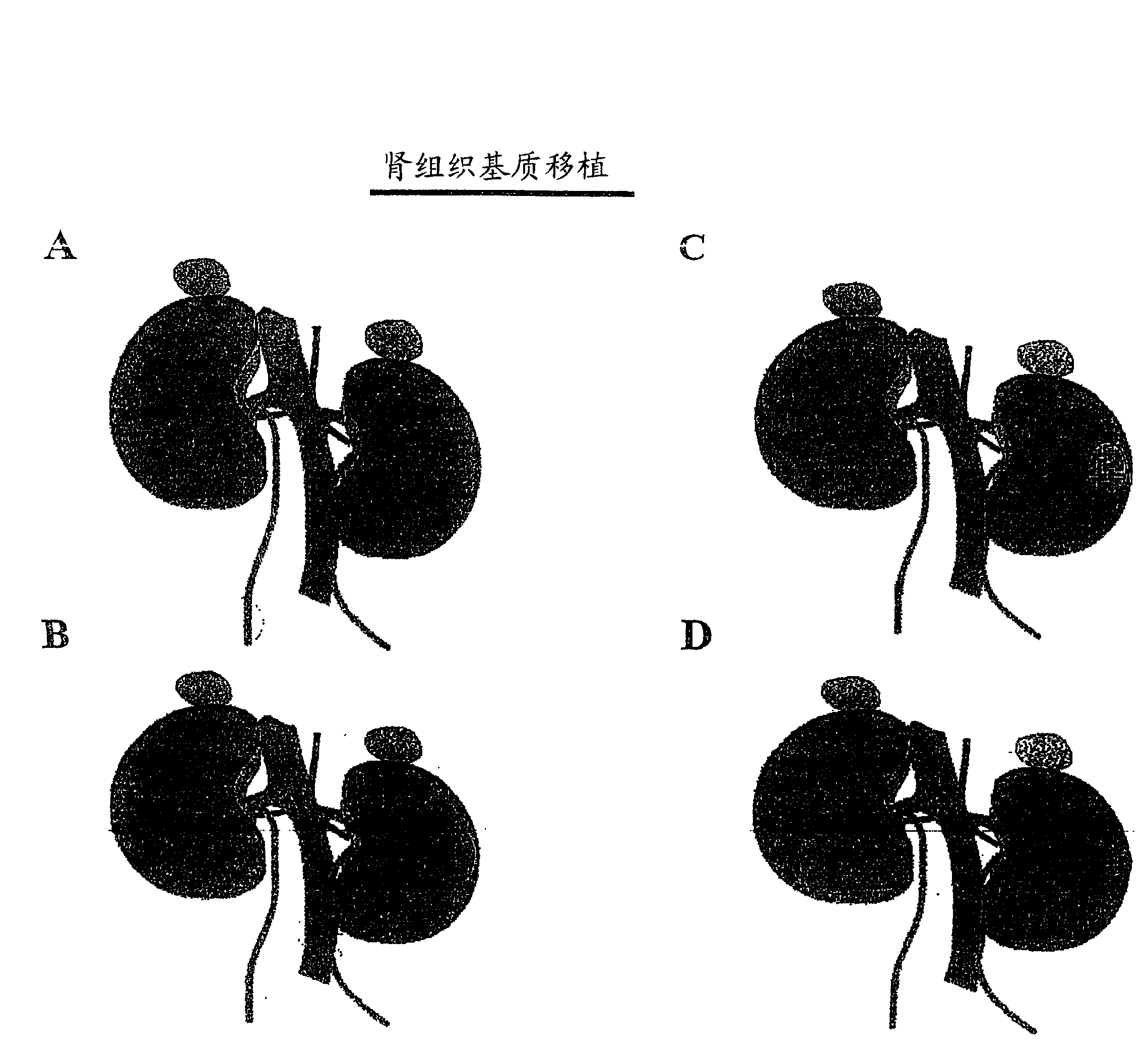Augmentation of organ function
一种器官、功能的技术,应用在细胞群增强器官功能领域,能够解决出现感染、削弱免疫系统等问题
- Summary
- Abstract
- Description
- Claims
- Application Information
AI Technical Summary
Problems solved by technology
Method used
Image
Examples
Embodiment 1
[0137] Example 1: Isolation of kidney cells
[0138] Small kidneys, such as those from one-week-old C7 black mice, were capsuled, dissected, and ground, and suspended in Dulbecco's Modified Eagles' Medium (DMEM; Sigma, St. Louis, MO), which cultured The base contained 15 mM Hepes at pH 7.4, and 0.5 μg / ml insulin, 1.0 mg / ml collagenase, and 0.5 mg / ml dispase, a neutral protease from Bacillus polymyxa (Boehringer Mannheim, Indianapolis, IN).
[0139] Large kidneys, such as porcine kidneys, are arterially perfused with Eagles minimal essential medium without calcium for 10 minutes at 37°C, within 3 hours of extraction. Then, supplemented with 1.5mM MgCl 2 and 1.5mM CaCl 2 The kidneys were perfused with 0.5 mg / ml collagenase (Type IV, Sigma, St. Louis, MO) in the same buffer as that used for the perfusion. The kidneys were then stripped, dissected, crushed, and suspended in Dulbecco's modified Eagles' medium (DMEM; Sigma, St. Louis, MO) containing 15 mM Hepes at pH 7.4, and 0.5...
Embodiment 2
[0141] Embodiment 2: the in vitro culture of kidney cell
[0142] I. Isolation of Rat Tail Collagen
[0143] Tendons were dissected from rat tails and stored in 0.12M acetic acid solution in deionized water in 50 ml test tubes. After 16 hours, overnight at 4°C.
[0144] Dialysis bags are pretreated to ensure uniform pore size and removal of heavy metals. Briefly, dialysis bags were soaked in a solution of 2% sodium bicarbonate and 0.05% EDTA and boiled for 10 minutes. Sodium bicarbonate and 0.05% EDTA were removed by rinsing multiple times with distilled water.
[0145] A 0.12M acetic acid solution including rat tendon was placed into a treated dialysis bag and dialyzed over a period of 2-3 days to remove the acetic acid. Change the dialysis solution every 3-4 hours.
[0146] (ii) Coating the tissue culture plate:
[0147] With about 30 μg / ml collagen (Vitrogen or rat tail collagen), about 10 μg / ml human fibronectin (Sigma, St.Louis, MO) and about 10 μg / ml bovine serum a...
Embodiment 3
[0151] Example 3: Isolation and culture of endothelial cells
[0152] Isolate endothelial cells from dissected veins. An intravenous heparin / papaverine solution (3 mg papaverine hydrochloride diluted in 25 ml Hanks' balanced salt solution (HBSS) containing 100 units of heparin (final concentration 4 μg / ml)) was used to improve endothelial cell preservation. The proximal filamentary loop is placed around the venous vessel and secured with a knot. A small phlebotomy is made close to the node and the tip of the venous cannula is inserted and held in place with a second node. A second small phlebotomy was performed beyond the proximal segment and treated with 20% fetal bovine serum, ECGF (100mg / ml), L-glutamine, heparin (Sigma, 17.5u / ml) and antibiotic-antimycotic Medium 199 / Heparin Solution Medium 199 (M-199) to gently flush the vein to remove blood and blood clots. With about 1ml collagenase solution (0.2% Worthington type I collagenase dissolved in 98ml M-199, 1ml FBS, 1ml ...
PUM
 Login to View More
Login to View More Abstract
Description
Claims
Application Information
 Login to View More
Login to View More - R&D
- Intellectual Property
- Life Sciences
- Materials
- Tech Scout
- Unparalleled Data Quality
- Higher Quality Content
- 60% Fewer Hallucinations
Browse by: Latest US Patents, China's latest patents, Technical Efficacy Thesaurus, Application Domain, Technology Topic, Popular Technical Reports.
© 2025 PatSnap. All rights reserved.Legal|Privacy policy|Modern Slavery Act Transparency Statement|Sitemap|About US| Contact US: help@patsnap.com


